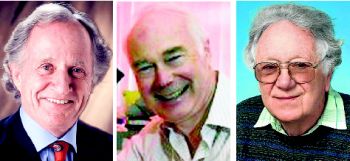Three Scientists Win Nobel For "Designer Mice"
Washigton: The gene-targeting methods, which assisted researchers make ‘designer mice’ is used by lots of research laboratories throughout the world and has facilitated, identifying the function of 10,000 different genetic materials.
 Three scientists, including 2 US scientists, Mario R. Capecchi and Oliver Smithies, and Martin J. Evans of Britain, have won the 2007 Nobel Prize in Medicine or Physiology for their job that was executed individually but when taken collectively made possible the ‘knockout mice, which are now solution to fundamental medical investigation.
Three scientists, including 2 US scientists, Mario R. Capecchi and Oliver Smithies, and Martin J. Evans of Britain, have won the 2007 Nobel Prize in Medicine or Physiology for their job that was executed individually but when taken collectively made possible the ‘knockout mice, which are now solution to fundamental medical investigation.
Martin Evans of Britain’s Cardiff University laid the groundwork by bringing out and dividing mice stem cells, the master cells, which fabricate a days-old conceptus and give rise to the whole living animal.
Evans solved how to hereditarily tinker with the cells and insert these changed conceptuses inside surrogate mothers that gave birth to mice with the preferred genetic alterations.
Mario Capecchi of the U.S. Howard Hughes Medical Institute and the University of Utah and Oliver Smithies of the University of North Carolina separately built up specific directions to stop, or destroy, a particular selected genetic material (gene).
Researchers have utilized their ways to genetically modify mice with human conditions including such as Alzheimer's disease, cystic fibrosis, hypertension, cancer and cardiopathy.
“It is now being applied to virtually all areas of biomedicine, from basic research to the development of new therapies,” the Nobel Foundation wrote in its declaration on the prize.
Capecchi stated that researchers had built up the way to modify any gene in the mouse ordination.
In a telephone interview, he told, “What that allows you to do is to then evaluate what happens. If for example, you see a little finger disappear, then you know that gene is important for making little fingers. That way you can infer what the function of any gene is.”
Capecchi stated that researchers’ cognized what they desired to perform - create genetically modified mice. But it was not simple.
“It took over 10 years just to develop the technology and now it is being used by hundreds of labs all over the world,” he said.
In a telephone interview, Jeremy Berg, director of the U.S. National Institute of General Medical Sciences, which funded some of the work, said, “Embryonic stem cells were key.”
“When you knock out a gene in an embryonic stem cell, you can take the cells and then turn them into a mouse. There are huge benefits to being able to see the impact not just on one cell ... but on a whole organism, living and breathing.”
The work has also assisted speed the commercial development of drugs.
Edward Lanphier, chief executive officer Sangamo Biosciences, said, “Their demonstration of the power and the impact of this technology in the
mouse highlighted the urgency of developing its use in cells of other species.”
But the utilization of human embryotic stem cells is divisive.
U.S. President George W. Bush has imposed strict restrictions on federal funding of the work, even though it is aggressively promoted in Britain.